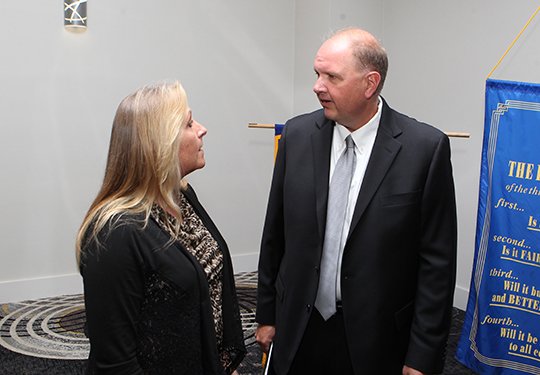Just two months after being named the new Hot Springs police chief, Jason Stachey is already looking at ways to work with neighborhoods to cut down on street-level drug transactions and blighted properties.
Those neighborhood-level actions are tempered by the recent fatal shootings of law enforcement officers in Dallas and Baton Rouge, La. Stachey, who was the featured speaker at Monday's Oaklawn Rotary Club meeting at The Hotel Hot Springs & Spa, said officers' training now has to take a new direction, "defense against an ambush."
"Of all deadly force incidents used against law enforcement, this is the most difficult to prepare and train for. The fact is, if there is someone who has the intent to do harm against us, they already have the upper hand," Stachey said. "In other words, we are solely reactionary at that point, until that officer sees that threat and can react accordingly to it."
The third group of Teen Police Academy students who graduated Friday were introduced to various scenarios that law enforcement officers have to go through daily as they participated in simulations at National Park College. The simulations placed the students in situations where they were tested on whether to use force against a subject. Training for law enforcement includes communication and empathy, force-to-force training to help officers make split-second decisions and escalation training to be able to calm down confrontational individuals.
In the coming months, Stachey plans to implement a drug unit that will target mid- to low-level drug dealers. They will work alongside the 18th Judicial District East Drug Task Force, but will focus on the lower dealers within the city limits. Studies show that 70 to 85 percent of violent and nonviolent crime are drug-related, he said.
"I, for one, will no longer stand by and watch drug transactions take place in broad daylight in parking lots in public places. We should not have to deal with that as citizens in Hot Springs," Stachey said.
To coincide with a new drug team, the enforcement of city code and nuisance abatement will soon increase. The Hot Springs Police Department will look into working with tenants, landlords and homeowners to keep up their properties to prevent abysmal appearances.
"I am a personal believer in the 'broken window theory,' which relates that a residence or neighborhood that begins to lose aesthetic appeal and falls into disrepair, i.e., 'broken window,' can invite a criminal element in that neighborhood. What it is showing is that these residences in our neighborhoods do not care about what it looks like."
Hoping to acquire "prediction" software, the police department would be able to see the problem areas in each patrol zone. The software Computer Statistics allows agencies to input information regarding types of arrests, their proximity to average high-crime areas and general times they occur. Supervisors could inform their officers prior to going out on patrol of where they should be at what time.
"We can give them the answers and let them know where they need to be between 8 and 10 p.m. that evening. So we have a more direct, efficient and effective way into addressing crime," Stachey said. "If we have had several burglaries along a specific corridor this software will tell us, along with a predictability module that may tell us where it is going to happen next. If we use it correctly, and how it is designed to, it will create accountability and provide another tool to fight crime."
Local on 07/26/2016